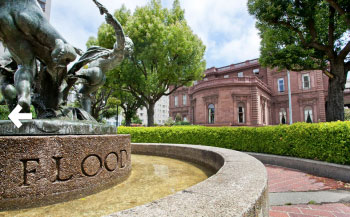San Francisco Neighborhoods

Nob Hill
Nob Hill is one of San Francisco's signature neighborhoods, renowned for its city landmarks and the famous hotels that border Huntington Park. For those who explore further, it also reveals unexpected facets. In addition to its swanky character, the area is influenced by the diverse personalities of the downtown neighborhoods that surround it, making it an intriguing place to visit.
The area's reputation of privilege dates back to Gold Rush times, when cable car lines made the hilltop accessible and the railroad barons and bonanza kings built their mansions there, far above the rowdiness of the bawdy waterfront. Luxury hotels now stand in the place of those original palaces, and when you hike to the top of the hill, historic buildings such as the Fairmont Hotel and the Flood Mansion are undeniably impressive, as are the lush cascades of bougainvillea and the genteel apartment buildings with their wedding-cake facades.
Venture away from Huntington Square and the terrain starts to change. Chinese temples and small businesses spill over from Chinatown, and over towards Union Square you find upscale boutiques. Funky shops and dive bars lie along the blurred edges of the Tenderloin (an area known as the Tender Nob), and the Polk Street boundary is lined with nightclubs and popular bars.
Some parts of the neighborhood feel frozen in time. The hill is dotted with vintage barber shops, old corner coffee shops and cocktail lounges from bygone decades. Nob Hill has also been home to some iconic San Francisco characters. Legendary columnist Herb Caen lived in the Brocklebank building, across from the Fairmont Hotel, and the neighborhood was home to Marian and Vivian Brown, the famous "San Francisco twins," known for their signature identical outfits.
It can be difficult to distinguish the precise boundaries of the Nob Hill neighborhood. This guide covers an area roughly bordered by Polk, Post, Mason and Washington Streets.
Sights & Culture
Cable Car Museum: The City by the Bay boasts the only operating cable car system in the world; if you want to be a true San Franciscan, it pays to brush up on your cable car facts. This free museum is housed in the city's cable car barn and powerhouse, a large brick structure, and features displays of historic cable cars, as well as live views of the winding machinery and cables for the Hyde, California, Mason and Powell lines, all in action. The small gift shop is crammed with a dizzying number of cable car souvenirs. 1201 Mason St., (415) 474-1887. (website)
Grace Cathedral Episcopal Church: The West Coast's largest Episcopal cathedral looms over Huntington Park with Gothic splendor, an imposing replacement for the original 1849 Gold Rush chapel. Of special interest are the cathedral's stained glass, its bronze doors (casts of those made by Lorenzo Ghiberti for the Baptistry in Florence), frequent concerts, and its pair of labyrinths. Circular paths of inlaid patterned coils, the labyrinths are intended for contemplative walking. The outdoor labyrinth is made of terrazzo stone, and the indoor path is woolen tapestry. 1100 California St., (415) 749-6300. (Web site)
Huntington Park: After the 1906 earthquake and fire destroyed the grand home of Arabella Huntington, widow of railroad baron Collis P. Huntington, she donated the land to the City of San Francisco to be used as a public park. The classic square forms the heart of Nob Hill, and with its shady benches and children's playground it makes an inviting place to pause after a hike up the hill. The Fountain of the Tortoises, a replica of one in Rome, features a mélange of cavorting turtles and nymphs and is lit by eight underwater halogen lamps that, during the holidays, are changed from clear to red, amber and green. At Jones and Taylor Sts.


